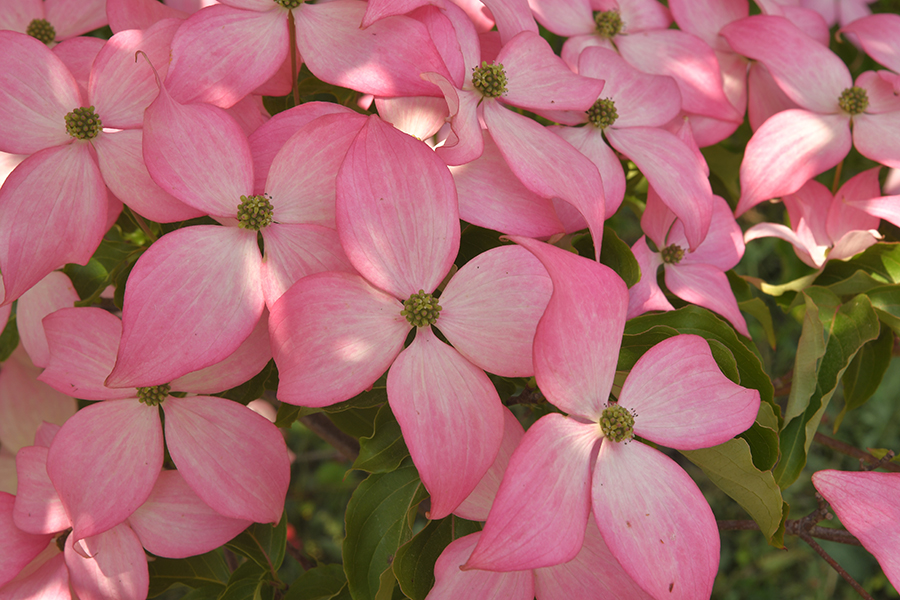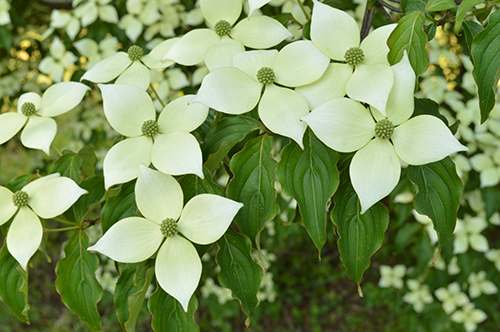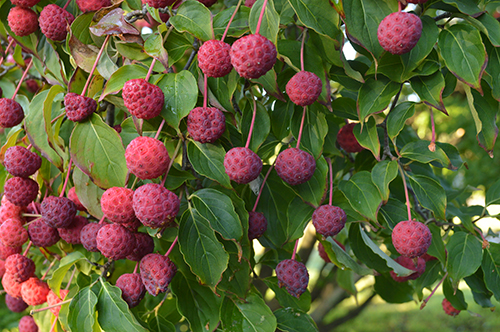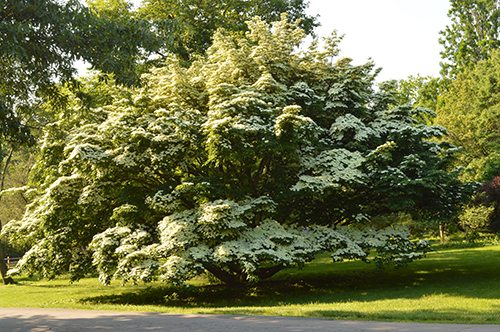
January brings chilly temperatures, snowfall and for the gardener, the pleasure of hunkering down in the warmth of a home with a good garden book! Afterall, why venture into the garden when there are but a few stalwart evergreens to enjoy. However, with a little thought the garden can display plenty of winter interest. For instance, I have long been a fan of plants with colorful or exfoliating bark, a subtle attribute many may fail to consider and a few even find undesirable. I fondly remember the comments of a former college roommate when I showed him a tree with exfoliating bark. "I would take a belt sander to the tree" he commented! Obviously, peeling bark is not for everyone. Fortunately, that sentiment is shared by only a few and I have found many a gardener who appreciates the bark of Japanese Dogwood, botanically known as Cornus kousa.
Cornus kousa (Picture 1) is a member of the Cornaceae or Dogwood family and is native to Japan, Korea and central China. The number of species is the subject of some confusion since it ranges from around 60–80 and this range varies depending on the source. The genus name was selected in 1753 by the Swedish botanist Carl Linnaeus (1707–1798). It stems from the Latin Cornu for horn or horn shaped, such as seen in the word Cornucopia! However, Linnaeus was not referencing a horn of abundance, but rather the hard and bony horns of animal antlers. In general, Dogwood produces a very dense and hard lumber that has been used from arrow and spear tips to cogs for wind and water mills. The common name of Dogwood may have developed from the old English Dag, meaning to pierce or stab, and is the root of the word Dagger. Once again, a reference to the hardness of the wood.
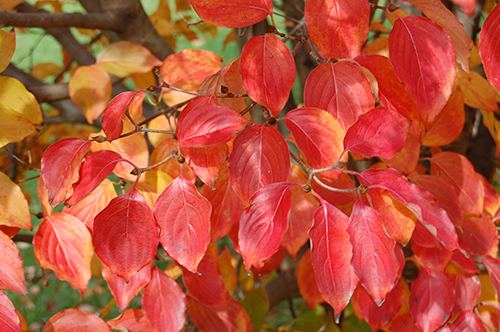
The species epithet is derived from a Japanese word for Dogwood and was initially crafted by the German physicist, biologist and botanist Heinrich Bürger (1806–1858), who is honored in the Maple named Acer buergerianum. Through an appointment from the Dutch government, Bürger was stationed in Japan from 1825–1835 where he studied and collected plants and animal life, initially working with the German physician and botanist Philipp Franz von Siebold (1796–1866). Much of his written work was published after he departed Japan and in the case of Cornus kousa, it was published posthumously in 1873. Unfortunately, the description was incomplete and was properly described by the British diplomate and plant devotee Henry Fletcher Hance (1827–1886). The name and incomplete description Bürger wrote must have circulated in botanical circles far earlier than its publication since Hance's work was published 6 years prior in 1866!
Japanese Dogwood is among those plants whose ornamental interest only grows as the plant matures. In youth, the plant is rather upright in habit and although it is certainly not unattractive, it does lack the grace that comes with maturity. With age, the plant assumes a more rounded habit and the branches develop an arching, vase-shaped habit (Picture 1). By contrast, the opposite deep green foliage is attractive from youth. The elliptical leaves emerge in early to mid-May and are 2½–4" long by ¾–1¾" wide with the tips coming to a sharp point. Typical to all Dogwoods, the leaves have arcuate venation, whereby the leaf veins curve as they approach the leaf margin, preventing them from actually reaching the margin. Some plants have keel-shaped leaves, which can also occur during extended droughts. Come fall, the foliage turns a gorgeous rich wine-red as seen in Picture 2 and often persists for several weeks before dropping.
The rich green foliage serves as a great backdrop for highlighting the flowers. The flowers begin to emerge in early May but do not develop their full potential until mid to late-May. The true flowers are located in a central, ⅜–½" diameter boss of small green florets that when open display golden yellow anthers. The flowers actually go unnoticed by most observers. What is observed and enjoyed are the four leafy white bracts that surround the central flowers (Picture 3). The bracts vary somewhat from plant to plant, but in general are 1½" long by ¾" wide and overlap slightly at the base. Like the leaves, the bracts come to a sharp point at the tip and the venation is once again arcuate. The flowers are perched on 2–3" long floral stems called petioles and appear to float above stems. From a distance, the flowers resemble a snowy coating atop the arching branches!
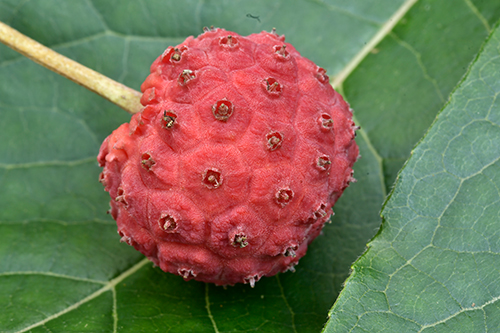
Following petal drop, the globe-shaped fruits slowly develop (Picture 4). Actually, they should properly be called a modified berry since the seeds and fleshy coating fuse into a compound berry called a syncarp. When seen closely (Picture 5) the individual 5-sided fleshy coating of each berry can be readily seen. Initially these 'compound berries' stand upright, but as their size and weight grows, the stems flex and they hang like ornaments. Come late summer, they have reached 1" in diameter with the color changing from green, to orange to deep red. Somehow, they have always reminded me of miniature soccer balls! The berries are also edible, although I would be hard pressed to call them a delicacy. They are gritty in texture with some trees offering sweeter pulp than others. They remain attractive from late August through September, before falling. In Asia, the fruit is eaten by Macaque Monkeys, rodents and birds while in NJ the uneaten berries can become rather messy for several weeks as they fall to the ground.
Interestingly, as the fruit is developing its deep red color in August, the winter bark interest to come is beginning to take shape! The older, dark gray outer bark of the larger stems is beginning to peel and flake, revealing the very attractive light tan inner bark. Although to some this process looks troubling (as seen in Picture 6), it is simply part of the natural process of the trunk enlarging. For most trees, the process of trunk growth coincides with the bark remaining intact and developing deep ridge and furrowed or platy bark in response to the cambium or 'wood' beneath the bark undergoing its annual growth. However, for a few the bark exfoliates to accommodate the growth. The exfoliation can also help the plant cleanse itself from disease or insects that are attached to the bark. The newly revealed light tan inner bark also reflects sunlight and may help the plant in winter by reflecting light and preventing the bark from undergoing fluctuations in temperature. Regardless, the bark is beautiful! I have noticed the size of the exfoliating pieces and degree of exfoliation varies from tree to tree. The process does not start until the plant is well-established and as the growth of the trunks slow with maturity, the process becomes less dramatic each year.
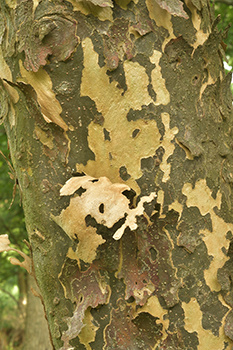
There is a mature tree at Rutgers Gardens (Picture 1 and 7) that I recently learned came from Willowwood Arboretum in Chester Township NJ as a seedling. It was accidentally mowed to the ground in its youth, resulting in multiple upright trunks. Along these trunks, numerous small pieces of bark magically 'pop off' to reveal a wonderful pattern of light and darker bark, as seen in Picture 7. I nicknamed it 'Patches' in honor of its attractive bark pattern, although the plant has never been propagated nor officially named. Even though the process of exfoliation begins in late August for most trees, the bark remains attractive throughout the winter. It is not until the following spring that this inner bark gradually darkens as it transitions into the outer layer and will in turn exfoliate come August as the process repeats. The trunks also develop a muscular undulating appearance over time, much like a well exercised forearm!
Of course, there are a number of wonderful selections to choose from, including Cornus kousa var. chinensis. Var. is short for variety, which designates a selection that comes true from seed. By contrast a cultivar, short for 'cultivated variety' is typically propagated asexually by rooted cuttings, budding or grafting. Variety chinensis was found by the plant 'hunter' E.H. Wilson in 1907 while exploring Hupeh (now Hubei) province in China. Wilson noticed that the plants had a noticeably larger flower, measuring 4–5" in diameter, as opposed to the forms from Japan with 3–4" diameter flowers. The fruits were also slightly larger, growing to 1¼" in diameter and the foliage a darker green. Described by the English gardener and botanist Arthur Osborn (1878–1964), seeds were sent back to the Arnold Arboretum and the plants disseminated to eager gardeners. The plants also have a narrower habit than Japanese seedlings although they still retain the attractive vase-shaped habit.
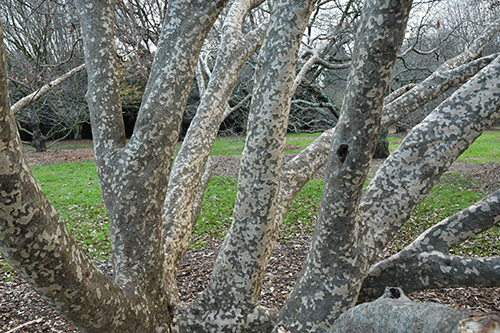
Of the numerous cultivars available, one variegated form I appreciate for a lightly shaded location is 'Wolf Eyes'. The foliage has a central green splash with a bright white margin speckled with green dots. Often some lighter gray-green areas can be found along the edge of the central green splash. With a little imagination, the leaf may resemble the eye of a wolf, yet from a distance, the white margin very effectively brightens a dark corner (Picture 8). It does not flower as heavily as the green forms, presumably due to less chlorophyl, which also explains why the plant grows more slowly. Originating as a branch sport at Manor View Farms in Monkton MD, the plant is listed as growing to 6' tall and as wide, but I have seen it reach twice that size after 20 years. The flower bracts are difficult to see against the variegation, yet on close inspection even the bracts are variegated with a very light green center and a clear white margin. It does produce fruit, but the fall color is the preeminent fall attraction as the white margins turn pink and the central green area a deep red as seen in Picture 9. After 20 years, no bark interest had yet to surface.


With one or two notable exceptions, I typically do not get excited about weeping plants. However, Cornus kousa 'Elizabeth Lustgarten' is one of those exceptions! Named after the wife of Baier Lustgarten, the owner of Lustgarten Nurseries in LI, the plant has a gracefully mounded habit that serves to very nicely display the flower display (Picture 10). The plant also has attractive fruit, fall color and winter bark display. I have often thought it would make a phenomenal espalier against an unassuming blank wall or tall fence.
Despite the large number of cultivars of Cornus kousa in the trade, a good red bracted form has remained the object of envy for many gardeners and has eluded horticulturists – until recently! Building on the plant breeding work conducted by Dr. Elwin Orton of Rutgers University, his successor Dr. Thomas Molnar succeeded in producing a deep red bracted seedling in 2009 that was named Cornus kousa Scarlet Fire®! Although Japanese Dogwoods will perform well in light shade, the bracts of Scarlet Fire® look their best in a sunny location, as they actually appear to ignite on fire, much as the name suggests (Picture 11)! The name of Scarlet honors the school color of Rutgers. Young plants may have soft pink or nearly white bracts, but after several years of establishment, the flowers will develop the typical deep pink coloration. As important as the color of the floral bracts are to the gardener, so is the growth habit and branching structure. Scarlet Fire® is a vigorous growing plant, providing a straight trunk that eventually gives rise to branches with the traditional arching habit, reaching a height and width of 14 feet after 13 seasons. The plant is still too young to know how the bark will develop, but knowing the plant I nicknamed 'Patches' is in its parentage, I suspect it will be good!
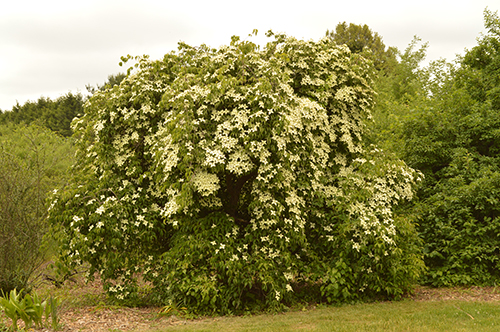
Disease resistant and hardy from zones 5–8, Japanese Dogwoods will grow well in full sun or light shade, although the best flowering and fall color develops in full sun. Well-drained yet moist soils with appropriate amounts of organic matter are ideal. Plants transplant well from a container or as a B&B specimen. Although Cornus kousa can be trained into a single stemmed small tree, I feel it looks more fitting when grown as a multistemmed plant that is pruned in youth to prevent the trunks from crossing or rubbing. The vase-shaped habit is ideal for framing a view or when used in pares, providing an attractive archway through which to walk. They would also prove to make an attractive allée and I have successfully espaliered the straight species and the weeping form alike on large or unattractive walls. Recently, Cornus kousa has been appearing on invasive plant lists. I have seen some seedlings during my years of working at Rutgers, but by comparison to other invasive species, they are relatively few in number. However, I have heard of plants that yield more seedlings and it is always important to remain vigilant.
Exfoliating bark may be merely one of the garden merits for Cornus kousa, but it certainly provides a touch of winter interest that many plants lack. Granted, it is not an asset that everyone may appreciate, but for most gardeners, the colorful patterns and textures provided by the bark helps to get us outside and enjoy the garden through those short and cold January days!
